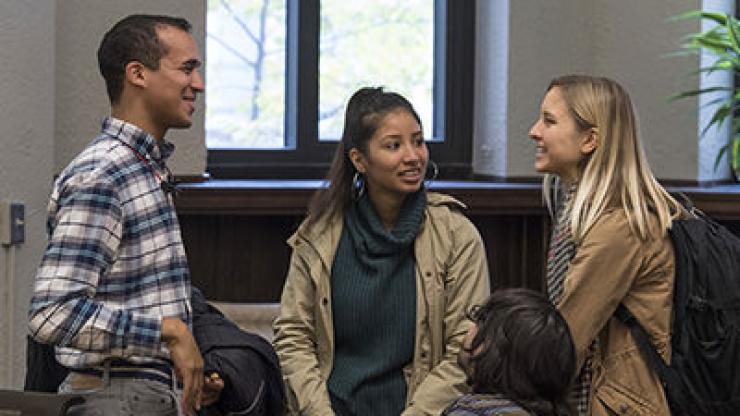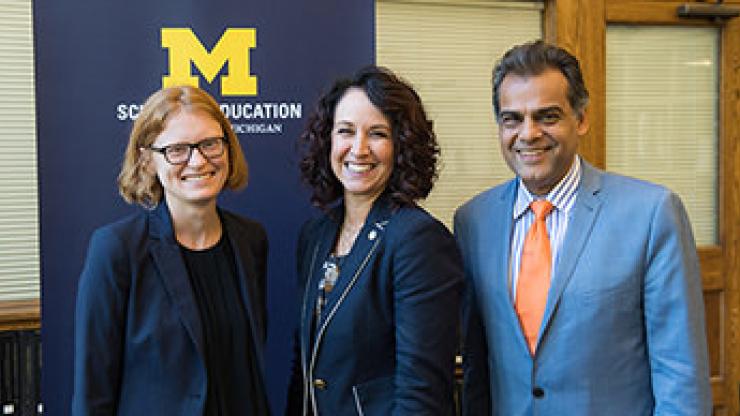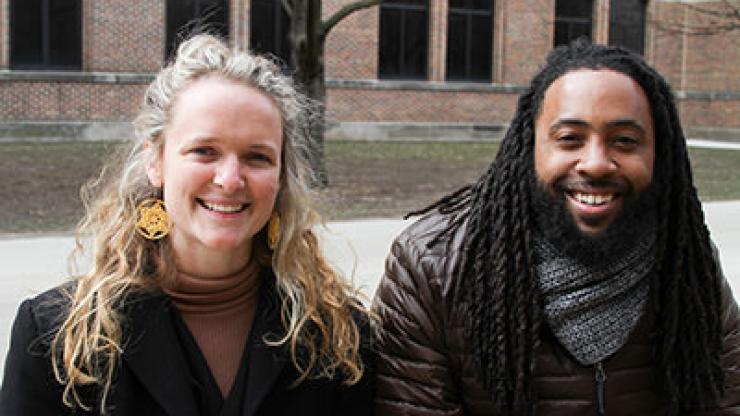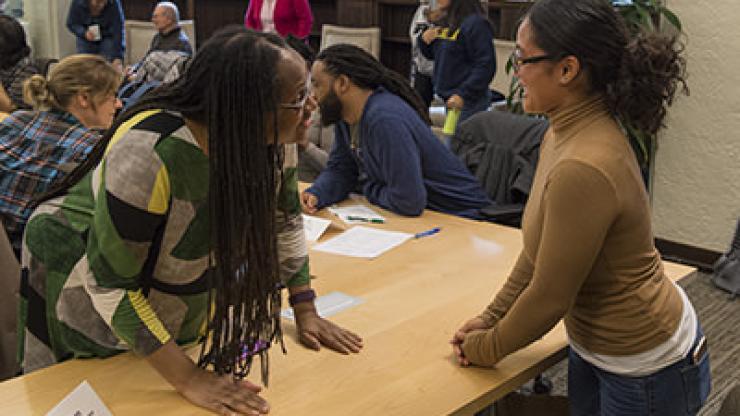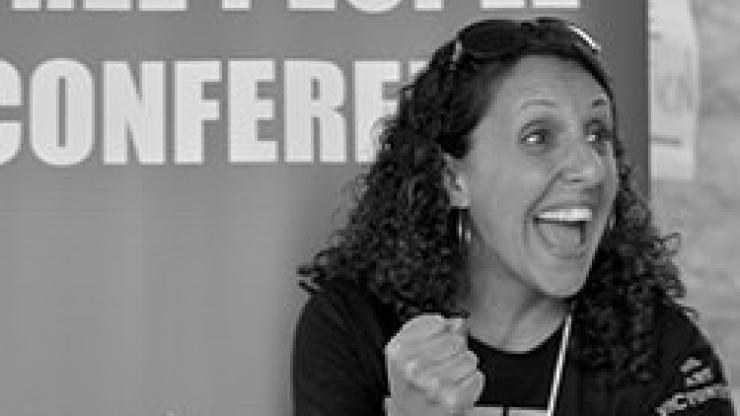dije
Learning to Teach and Teaching to Learn: Undergraduate Students’ Inspiring Role in SOE’s Ann Arbor Languages Partnership (A2LP)
Ann Arbor Languages Partnership (A2LP), a program that teaches undergraduates to teach Spanish to 3rd and 4th graders in Ann Arbor Public Schools, was founded by Marsal School Clinical Assistant Professor, Dr. Maria Coolican, and Marsal School Professor of Teacher Education, Dr. Donald Freeman. They established the partnership after a meeting ten years ago with the then superintendent of Ann Arbor Public Schools.
“Once they realize that you are invested in them, they are so excited to see you, and then that translates into being excited about Spanish. This program isn’t about having all the right tricks and being the best at saying the vocabulary, it is more about making connections with your students and inspiring them to be excited and engaged in the language.” – A2LP Language Teaching Assistant, Keith Sims
Today, A2LP it is still going strong as an inclusive SOE partnership that develops undergraduate students’ teaching skills as they offer Spanish language instruction and foster cross-cultural appreciation and awareness among young children in our local community. Dr. Coolican directs A2LP and is assisted by Research Manager and Curriculum Coordinator Dr. Claudia Cameratti-Baeza, and Graduate Student Instructor Martha Epperson. Approximately 75 SOE undergraduate students, called Language Teaching Assistants (LTAs), participate in the partnership each year. They teach nearly 2,000 local elementary school students per week in more than 75 third and fourth grade classrooms in 19 schools around the city.
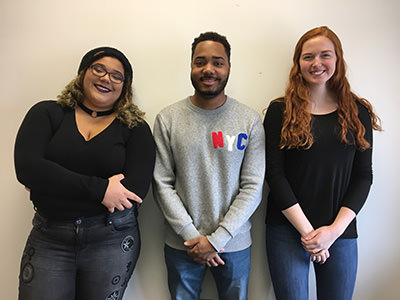
SOE dije Graduate Student Staff Assistant Eloise Reid interviewed three LTAs, including Maia Zvetan, Keith Sims, and Kayce Mullett, who reflected on their experiences serving as A2LP teaching assistants. Maia Zvetan is a senior in the International Studies program with a concentration in Comparative Culture and Identity. Keith Sims, also a senior, is studying Biopsychology, Cognition, and Neuroscience, while Kayce Mullett is a sophomore majoring in the International Studies program with a concentration in Global Health and Environment. All three LTAs shared their excitement for teaching and commented on the ways they are gleaning insight into the role of diversity, inclusion, justice, and equity as they build meaningful relationships with diverse local students.
Read excerpts from their interview:
What brought you to this teaching work and the A2LP Program?
MZ (Maia Zvetan): Two years ago, another student in my (U-M) Spanish class was so excited about it so I signed up after checking (A2LP) out online. After listening to Martha (Epperson), Claudia (Cameratti-Baeza) and Maria (Coolican) during the orientation, their passion really solidified that this was something I wanted to do. I also wanted to see these kids have the same experience I had in terms of discovering new languages and cultures, and falling in love with them.
KS (Keith Simms): I was enrolled in an upper-level Spanish class and one of the (A2LP) participants came to speak about the program and all of the different things you get to do. At the time, I was pursuing a Spanish minor, and you can receive Spanish credit for working with A2LP, so I thought that would be an excellent opportunity. Also, I have been working with kids in various ways my whole life, so I thought it would be another interesting experience to teach kids Spanish.
KM (Kayce Mullett): I also spoke to a student who highly recommended the program, and was also inspired by a presenter who came into my Spanish class. I didn’t know how important Spanish would be to me until my senior year of high school when I had an amazing Spanish teacher. I thought about the influence of that one person and how that was the difference between me falling in love with Spanish or just letting it go after high school. I thought, “why not try and be the person who was really passionate about it,” and try and spread that to other people. It is really amazing to be able to separate yourself from school (U-M) like that sometimes.
What do you feel the biggest takeaway from the A2LP program has been?
MZ: For me, that would be really hard to boil down to just one thing. I am also pursuing a Spanish minor, and working with A2LP brings a different perspective to the academic side of it and that has been really nice. Seeing the kids go from, “I don’t know any Spanish, I don’t want to speak in Spanish, this is so scary” to “alright, I am going to try and give you a complete sentence in Spanish every time I answer”—seeing that progression and watching the kids become more comfortable and confident in themselves is incredible! They become much more confident about being heard and listened to by the adults in their lives. It is very rewarding. You are in the classroom to teach them Spanish but you are also showing them what they can become, and what they have inside themselves, and you learn how to nurture that.
KS: I have two different takeaways from two different perspectives. Speaking as a teacher, this program helped me realize how much work and preparation goes into teaching. We are only teaching two days a week so now I have realized how much more work it must be for a teacher who is teaching many more classes. Working with students has been really rewarding. Watching how much they are learning and seeing them go from a student who does not know a lot of Spanish, to now speaking complete sentences in Spanish is amazing.
KM: I think it is very interesting and valuable to have a small part of the week switched in terms of roles. Every other moment that I am not teaching in A2LP, I am a student here (at U-M) where it is all about learning material, trying to prove yourself, and demonstrating your knowledge. When you get to switch that up, for the short period of time where you are the instructor, you see that you want your student to be passionate and involved in what you are teaching. This perspective has helped me understand my role as a student. When I first arrived at the University, I was very nervous to attend my professors office hours, or I felt like I should know everything already and I was worried about that. But teaching these students has taught me to also become a better student myself. It is helpful to see what it is like in the instructor’s shoes, and understand that you are there only because you want to teach. You want your students to become engaged. Being a teacher has helped me grow as a student.
Has A2LP given you any new insights into the work of diversity, inclusion, justice or equity?
MZ: I try to bring in as many cultural or diversity elements to the lesson plan as I can when I am teaching. I am a goofball and will market those elements of the lesson plan off as “cool facts!” to the kids so they can process it in their own ways. I think that the kids process the diversity, equality, and justice components of the lesson on a different spectrum than we do. It can be as simple as explaining to the kid who says, “That is so weird! Why do they do that?” that it is important to recognize other cultures’ and countries’ rituals and routines. You bring all these different perspectives into the classroom, so they are all learning about themselves and each other, but also culture as a whole.
KS: One thing that I was surprised about was that at Allen Elementary, where I teach, the represented racial and ethnic diversity is very impressive. I also have native (Spanish) speakers in my classes, and sometimes I will pronounce a word and they will say, “Oh that is not how it sounds where I am from, or in my culture.” So then I will take the time to break it down and explain to the class that even with Spanish there are many different variations depending on who is speaking it and where it is being spoken.
KM: The students you are actually teaching are so diverse. There are native English speakers, native Spanish speakers, and people who are still learning English. I also think that the structure of the program is exciting. A2LP brings college students who don’t have a background in teaching from all different disciplines and has them teach, so the very nature of the program is collaboration. When you put us all in one room you are creating one giant, collaborative, Spanish teacher-monster who goes out and teaches hundreds of Ann Arbor’s third- and fourth-graders every week! It is just so wild!
What is a challenge you feel you have overcome during your time at A2LP?
MZ: Some of the challenges that I am overcoming are my own, not as much about the teaching atmosphere itself. Maria, Martha, and Claudia really give you all these excellent techniques and this great information that you can use in different settings, and so all of the planning feels natural. It is really about overcoming your own self-doubt and going with the flow of the lessons. When you get the exam scores back, you can also see your success! It is rewarding.
KS: I had to find who I was as a teacher myself, and was able to express that and show that off. Now that I am a solo teacher, I feel like I have come into my own teaching, and I think that the students definitely respect me more and I have a better connection with them. I am able to see what I am doing right, what I am doing wrong, and what I can continue to improve on. And how I can help them learn as well. It has really helped me find myself as a teacher, because now I am able to focus, change things, and make them as good as they can become.
KM: I realized it was about the connection you can make with the students. We have five minutes in between classes, and I started lingering around and telling students how well they did in that lesson or asking what they did on the weekend. Once they realize that you are invested in them, they are so excited to see you, and then that translates into being excited about Spanish. This program isn’t about having all the right tricks and being the best at saying the vocabulary, it is more about making connections with your students and inspiring them to be excited and engaged in the language.
Can you share an anecdote from your time in the classroom that you feel is relevant to the topic of dije? Or just a sweet memory from working with the kids?
MZ: I walked in one day as the class that I taught last year was coming outside, and they all saw me and yelled “Señorita!” and started speaking to me in Spanish. This group included some of the kids who were not engaged in the beginning of the program, so to see them have such a positive reaction to me, and to have their immediate thought to be to speak to me in Spanish, was very rewarding.
KS: One day I was teaching and my first class had a sub, so they were kind of off the wall. I had to keep trying to get their attention and it was difficult. I went into my last class of that day and they were all happy to see me and started saying “Español! Español!” That just made me feel awesome, showed me how far I had come with them, and how much they now really enjoy Spanish and learning.
KM: Just last week one of my students said, “I know we are more than halfway done with Spanish, but before you leave can you give us a big packet of all the words we have learned?!” When your students want to know more than what you can even fit into the time that you have, you know that you have done something right!
Indeed, under the guidance of SOE faculty and staff, Maya, Keith, and Kayce are wonderful examples of undergraduate students making an important difference as they contribute to SOE partnerships and their ability to enhance local school communities!
MORE FROM Expansions Vol 2
The Marsal Family School of Education is proud to be a leader in the campus-wide initiative promoting Diversity, Inclusion, and Equity. Adding "Justice" to these values underscores the role of educators in the creation of just societies. Through research, public scholarship, community building, and the preparation of education practitioners and policymakers, we articulate and advance our dije agenda.
